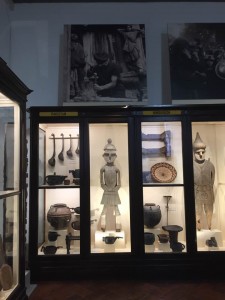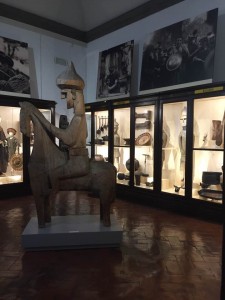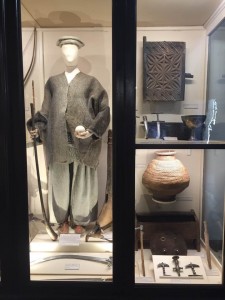

By Rachyl Grussing (Istituto Lorenzo de’ Medici)
The Museum of Anthropology and Ethnography in Florence has been collecting for over 400 years. The oldest objects in the museum are from the Medici collections, but they also boast items from expeditions as recent as the 1990s. While the museum displays a wide array of objects, it also suffers from being an institution in the midst of change. For the past several years the museum has been slowly reinventing their displays in response to the public pressure to correctly display the cultures contained with its walls. The newest part of the museum opened in August of this year, and is a continuation of their attempt to change the historical nature of their displays.
The room focuses on objects from the Hindu Kush valley between Pakistan and Afghanistan and displays things from three different cultures of that region: the Kalasha, the Hindukush, and the Nuristani. Objects displayed in this particular room were gathered in several expeditions in the late 1950s and early 1960s. The main one, headed by Paolo Graziosi, is featured in a small documentary that plays on a small screen on the far side of the space. The documentary is in Italian, but does feature English subtitles. This documentary allows for the visitor to see the area where the objects were gathered in movie form, but the audio of the film is very loud and the sound bleeds into other rooms of the museum.
Directly in front of the window of the room is a panel with information about the different cultures in the room, but the information is very basic. There are also laminated sheets with information in many different languages that supplements the information on the main panel. There are two types of labels within the cases, simple labels that tell the basic information of the object, or longer labels that give a quick description of the purpose of the item in question. Above the historic nineteenth century cabinets are blown up photographs of the people from the HIndu Kush valley going about their everyday lives with the anthropologists in residence. On the opposite wall there is also a large map, with a yellow circle denoting the geographical location of the valley.
Together, these give an overview of the culture and geography of the area, but there is no descriptions of the meaning behind the objects in the cases, many of which were used for rituals. However, taken as a whole, the room does not do much to educate the visitor on the importance of the objects. The exhibition in this room is the result of a direct collaboration between the native communities and the museum, but this information is not readily available to the everyday viewer. The preservation of these ancient cultures seems very superficial. The text provided does help to give some context, but it is not placed in such a way that it is obvious to visitors.

Traduzione di Tania Mio Bertolo (Università degli Studi di Firenze)
Il Museo di Antropologia ed Etnografia a Firenze ospita una collezione raccolta nel corso di più di 400 anni. Gli oggetti più antichi qui conservati provengono dalla collezione dei Medici, ma ve ne sono anche alcuni acquisiti dal museo negli anni ’90 in occasione di recenti spedizioni. Nonostante il museo vanti una collezione molto ricca, soffre della situazione di cambiamento che esso stesso, come istituzione, sta vivendo. Diverse volte in passato il museo ha rinnovato il proprio percorso espositivo per far fronte alle pubbliche pressioni direzionate ad un allestimento che più correttamente valorizzasse le culture delle quali esso conserva memoria tra le proprie pareti. La parte più recente del museo è stata aperta al pubblico nell’agosto dello scorso anno, e costituisce un ulteriore contributo allo “svecchiamento” della natura storica del proprio allestimento.
Il nuovo ambiente è dedicato all’esposizione di quegli oggetti provenienti dalla valle di Hindu Kush, collocata tra il Pakistan e l’Afghanistan, e mette in mostra le testimonianze delle tre diverse civiltà che abitano quella stessa valle: i Kalasha, gli Hindukush ed i Nuristani. Tali oggetti arrivarono al museo in seguito alle spedizioni promosse tra la fine degli anni ’50 e gli inizi degli anni ’60. Viene fornita testimonianza della principale tra queste, quella capeggiata da Paolo Graziosi, attraverso un filmato proiettato in un piccolo schermo collocato su un lato della sala. Il documentario è in italiano, ma con i sottotitoli in inglese. Esso consente ai visitatori di osservare per immagini l’area nella quale gli oggetti furono trovati, tuttavia l’audio del filmato è troppo alto ed invade rumorosamente le sale adiacenti.
Esattamente di fronte alla finestra della sala si trova un pannello con poche e riassuntive informazioni circa le diverse civiltà alle quali è dedicato tale ambiente. Vi sono anche fogli laminati compilati in lingue diverse che forniscono informazioni aggiuntive. Queste targhette, spesso posizionate presso le teche espositive, forniscono talvolta scarse indicazioni circa l’oggetto al quale sono associate, altre invece contengono un testo più lungo che riassume velocemente le peculiarità e la destinazione d’uso del pezzo in mostra.
Presso il gabinetto storico del diciannovesimo secolo si trovano fotografie ingrandite che ritraggono gli abitanti della valle di Hindu Kush impegnati nelle loro attività quotidiane affiancati dagli antropologi. Nella parete opposta vi è una grande mappa nella quale è segnalata in giallo la localizzazione geografica della valle.
Nell’insieme la sala fornisce una panoramica della cultura e della geografia dell’area, ma non vi sono abbastanza descrizioni dei significati e delle destinazioni d’uso delle testimonianze in mostra, molte delle quali avevano originariamente finalità rituali. Nel complesso la sala non educa a sufficienza il visitatore all’importanza di tali oggetti. Nonostante la collezione della sala sia il risultato di una diretta collaborazione tra le popolazioni native ed il museo, questa informazione non è prontamente captabile dal visitatore. La presenza di queste antiche civiltà sembra essere solo superficiale. I testi forniti di fatto aiutano ad una contestualizzazione di tali testimonianze, ma la loro posizione defilata li fa passare quasi inosservati al pubblico.